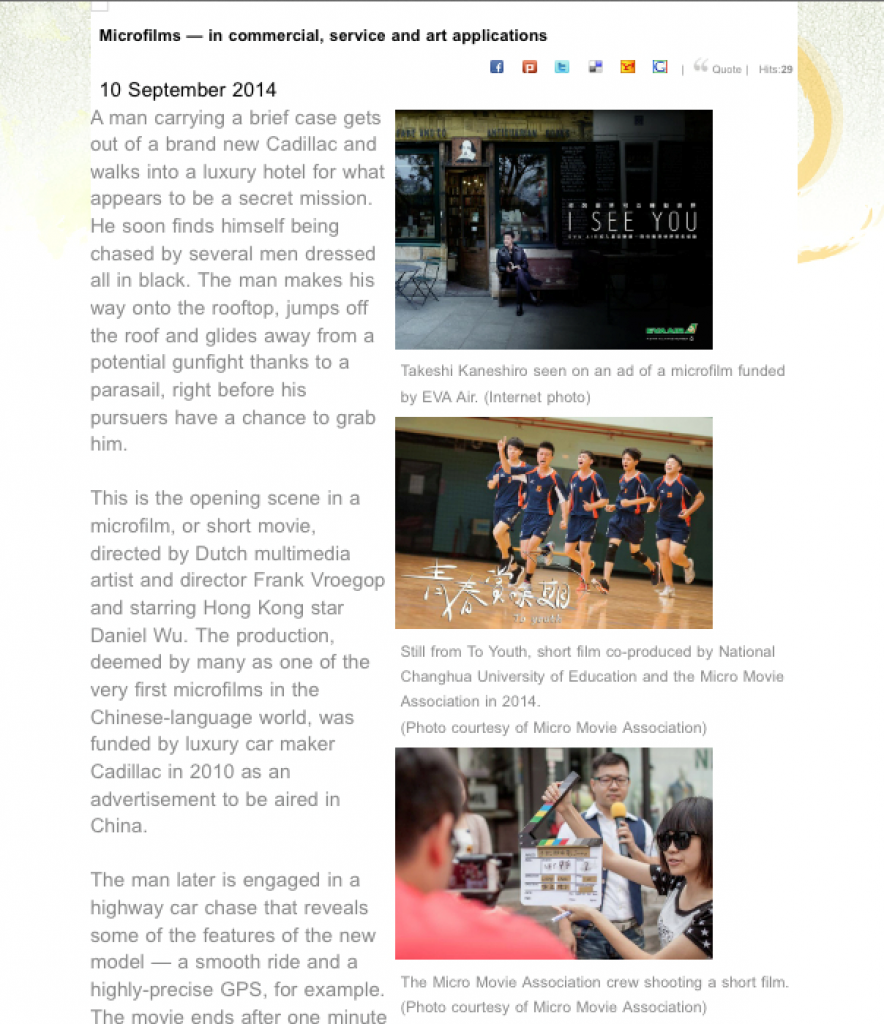2014年9月文化部英文網站針對台灣微電影現況的採訪報導
A man carrying a brief case gets out of a brand new Cadillac and walks into a LUXURY HOTEL for what appears to be a secret mission. He soon finds himself being chased by several men dressed all in black. The man makes his way onto the rooftop, jumps off the roof and glides away from a potential gunfight thanks to a parasail, right before his pursuers have a chance to grab him.
This is the opening scene in a microfilm, or short MOVIE, directed by Dutch multimedia artist and DIRECTOR Frank Vroegop and starring Hong Kong star Daniel Wu. The production, deemed by many as one of the very first microfilms in the Chinese-language world, was funded by luxury car maker Cadillac in 2010 as an advertisement to be aired in China.
The man later is engaged in a highway car chase that reveals some of the features of the new model — a smooth ride and a highly-precise GPS, for example. The movie ends after one minute and 34 seconds with the mission accomplished.
This is a successful microfilm — with a full storyline, a famous star and even a small plot twist within a very short frame of time, it aroused quite a bit of attention in its target market in China.
Sensation-stirring tools
In another short movie aired in 2013, a commercial for EVA Air, Taipei-born Japanese ACTOR and singer Takeshi Kaneshiro strolls alone on the street of Paris, sits pondering at the door of Shakespeare and Company, and enjoys the tranquility of a Japanese garden with a cup of green tea in Nara, Japan. When he finally reaches Taitung in eastern Taiwan, he rides a bike along a country road and rests under a tree, followed by a voice-over in which he says, “I see the world, I see people, I see you… Change the way you see the world”.
This expression has become so popular in Taiwan that even people who don’t understand English know what it stands for. The place where Kaneshiro rides the bike is often crammed with tourists during weekends, and the tree has become a local landmark.
This is what most microfilms seek to achieve—to create sensations for merchandise, an issue, or an ideal.
According to materials provided by the Microfilm Center at the National Taichung University of Science and Technology (NUTC), microfilms can be made for various purposes such as promotions for public welfare or charity, image presentations, business commercials or personal creations. A microfilm is often considerably less than 20 minutes in length. For many microfilms, like the one for EVA Air, a shorter version is aired on TV, luring viewers to look for the full-length version on YouTube or other online streaming services.
Microfilm as a product of a fast-paced modern society
The term microfilm was coined by the Greater China entertainment circle amid the rise of a generation characterized by a mobile, fast-paced lifestyle. As Yu Sung, a scholar at Shanghai University, points out, one reason the shorter format of FILMS has been so popular may be that audiences nowadays, living under time constraints and relying heavily on mobile devices, find microfilms easily accessible, as it they are capable of telling a complete story within a short time frame on mobile devices.
Micro movies also inspire new, innovative and flexible ways of making films. Unlike producing traditional movies, one can break through the barriers of monopolistic modes that dominate the making and marketing of movies because they can be presented via various online platforms which also enable producer-viewer interactions not often seen with traditional films.
Sung points out that viewers are a lot more tolerant of commercialized short films than they are of the placement marketing seen in many conventional movies. In other words, they are more effective for brand managers seeking audience identification. Instead of forcing an audience to watch product placements that often have little to do with the movie itself, as one often sees in movies nowadays, in short films, products or ideas are presented by stars in a story that may be catchy, interesting, or emotionally arousing and attracts viewers to share the link to the video voluntarily. The audience thus connects more positively to the product or merchandise brands being advertised via the short films.
The same effect can be applied to PROMOTING social welfare or policies. “Believe”, a short film produced by Taiwan’s Ministry of Labor in 2013, is an adaptation of the life story of Hsin-Yi Chu, the island’s first blind counselor to pass the entrance exam for a senior government service post. Unlike multimedia productions by the public sector that are often perceived as rigid propaganda, the nine minute and 30 second, commercial cinema-quality film presents a sophisticated, artistic portrait of the setback a blind girl encounters when she needs to explore the world by herself, and the dilemmas her father faces during that process.
Development of microfilm
The microfilm differs from the microcinema originated in the West. While microcinema is generally perceived as short, digital, low-budget productions in relatively cheap formats made by a small number of people, microfilm, which is a marketing tool that is gradually gaining ground, could be made with a big budget.
“Microfilms can be said to be the longer version of a commercial,” said En-Pei Yang, a producer and the director-general of the Microfilm Center at the National Taichung University of Science and Technology (NTCUST) during a phone interview. There is no forma rule on the size of the crew or the scale of shooting, because “the budget determines the production” and the budget could be as much as a low-budget traditional movie, Yang implied.
What distinguishes made-in-Taiwan films from others, then?
“Taiwanese-made films carry a unique affection for the native soil,” said marketing expert Chongda Tang. “And that affection comes with good manners originating in one’s heart.”
While a product being advertised in a short film must be well presented, as Yang has pointed out, Tien-lun Yeh, a Taiwanese filmmaker, said that the commercial part of the production must not be too obvious. “Taiwanese audiences value feelings and connections very much,” he said, “so instead of bluntly presenting the product itself, we turn it into something they can connect to.”
In Taiwan, there are a number of talent-training institutions for micro movies. The Micro Movie Association aims to promote the creation and marketing of films, industrial development, and international exchanges. Microfilm competitions and festivals are held from time to time. The other training institution, the NTCUST Microfilm Center, aims to train and connect young talents interested in the making of microfilms or pursuing a career in related fields to the industry. Various online service providers such as Yahoo! also provide platforms for short film producers to showcase their works.
Written by Carol Hsieh / culture.tw















